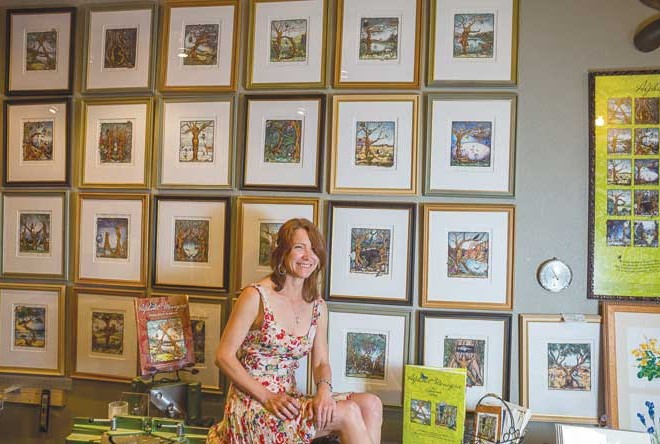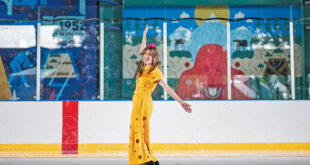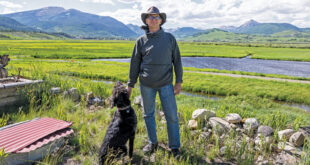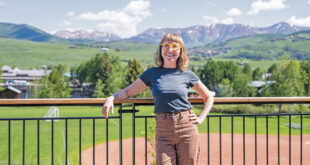by Dawne Belloise
A tattoo of a red-breasted sparrow gracefully flies from the inside of Lian Canty’s delicate forearm, symbolizing freedom. Lian explains that the same tattoo was commonly inked on released prisoners of the early 1900s in Great Britain to represent their freedom and remind them of their quest never to return to the confines of a cell.
Lian had the body art done at a particular turning point in her life, in a moment of deliverance, the same concept as the branched tree person, an uplifted spirit that she designed and now permanently dances up her ankle. Lian expresses her life through her art.
“I’ve been involved in the arts in Crested Butte for a long time,” Lian says, as one of the original members of Artists of the West Elks (AWE) and its first president. Through her art, along with Dana Bradley, she helped get Crested Butte designated the Wildflower Capital of Colorado. However, she also notes, “I was spending so much time helping others to promote their artwork that I didn’t do my own art for lack of time.”
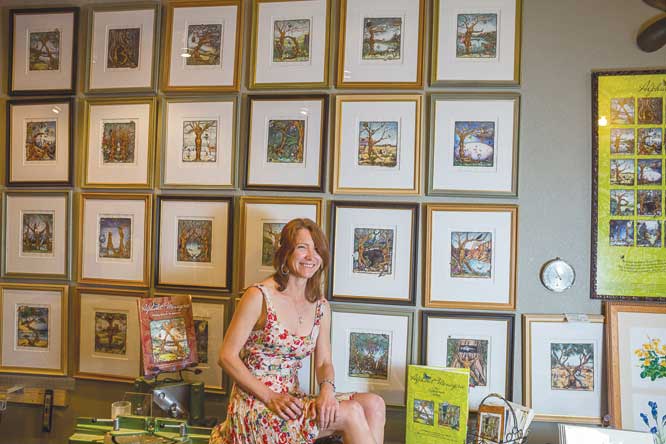
As a shop owner of Rendezvous Gallery and Framing, Lian was also raising her two children, Laurel (now 23), and Guthrie (19). “My art time was literally between 10:30 p.m. and 2 a.m.,” Lian says of the only creative time available to her. “Now I’m focusing more on my artwork, but the framing is still very important to me. It’s my bread and butter.” But she adds that she’s now allowing enough time for her own art. “I tried to leave once,” she laughs about her foiled plan to move out of Crested Butte, “but family kept me here. As an artist, I could find more of a niche elsewhere but I’ve managed to create my own niche here.”
Lian was born and raised in Leadville, Colo. Her father was a civil engineer for Amax but was a taxidermist on the side, specializing in fish. The fish mounts at Dragonfly Anglers are his and he was well known throughout the West for his work. Lian confesses that she doesn’t fish at all, and her mother was busy raising six kids and helping to take care of the taxidermy business’ accounting.
“Leadville was a rough town, it’s pretty red-necky,” Lian remembers, although the family lived out of town so she never saw the violence that sometimes occurs in mining towns. “What happens in a mining community, which is on rotating shifts, is that because the schedules were always changing it caused domestic problems. One week your dad would be home for dinner and the next he’d only be home for breakfast,” she explains.
Then, in the late 1970s Amax laid off 3,000 workers from the Climax mine and within a year Lian lost about a third of her junior high school class. “Driving around Leadville it seemed like every other house was abandoned,” she says. She emphasizes that she’s not a proponent of mining because, “I’ve seen what it does.”
Lian graduated from Lake County High School in 1985. Through her high school years, she had saved up enough money while working banquets as a waitress in Vail to buy a car and also go to Europe, traveling through Germany, London and Paris. Lian had already been accepted to Rocky Mountain College of Art and Design and, heeding a suggestion from her mom, studied graphic arts because those were skills that she could make a living from. She took a full immersion program of two straight years with no summers off. It was all art, all the time and she graduated in 1987.
That was also the year she married Dave Moore and they moved to Crested Butte the following year. “My dad had done a fishery project in North Pole Basin for Bo Callaway. Dad rehabilitated streams to encourage native trout, so I knew of the area through dad. “
At the time, Crested Butte was affordable and it seemed to Lian that it was an up and coming artist community. Both of her children were born here. “We opened the Rendezvous Gallery and Framing above the Gourmet Noodle. I worked other jobs to support us until the gallery got going,” Lian says of her stint at Rozman’s Motor Lodge and BBQ, where she got to know some of the old timers. “There were quite a few old timers still left and they’d hang out and drink coffee at Rozman’s Restaurant,” she recalls.
Lian also worked at Stem’s Floral as a flower arranger, the Teeshirt Shop, and the Grand Butte Hotel, all the while learning how to frame and eventually working more full-time in their gallery-shop.
Throughout her various jobs Lian created her fine art, and one of her first series, the Tree People, sold so quickly that she has no records of most of that work. She started painting and drawing botanicals, which were an already acquired fondness of hers, the style reminiscent of the antique botanical illustrations from the golden age of botany, the 1600s through the 1800s.
Lian explains that those centuries of illustrations were the beginning of scientific referencing: “The botanists at the time wanted to identify flowers and the only way they could do that was to create drawings of them,” she says. Lian created posters of hand-colored wildflowers to promote the Antique Botanical Show and Sale, which she and her husband put on in conjunction with the Turner Art Gallery in Denver. The Denver gallery had a huge collection of antique prints that were her first inspiration for her botanical creations.
When her marriage ended in 2008, she retained the Rendezvous Gallery, moving it seven times, and she currently shares a space with Shock Therapy and electrician Rich Driscoll, an odd coupling, but she laughs, “We’ve known each other forever and we were talking about how we both ended up talking to ourselves when we were working alone and it just worked to jointly share this space,” she says of their year and a half studio partnership.
Lian’s medium changes depending on whether she’s creating commercial or fine art. On the walls of her current studio are large canvas oil paintings. A bouquet of muted multi-colors, transparent layers of flowers like sheer curtains that allow subtle figures to shine through. She calls this series “Lyric Forms.” Lian explains, “It’s an oil paint glazing technique where you thin the paint so it becomes transparent so all the layers show through, creating depth and a sense of illumination. They take forever because you have to let each layer dry.”
To supplement her Rendezvous Frame and Gallery work, Lian also creates masterpieces of calligraphy—invitations, announcements, poems, usually in ink. “I like to grind my own ink, which I do traditionally with an ink stick and a grinding stone. An ink stick is dried pigment that is pressed together into a block or a stick. The ink stands up on top of the paper and has a more beautiful feel to me when it flows through the brush or pen. When the ink stands up on the paper, instead of soaking in, if you need to correct something, you can scrape off the layer of ink.
“I’m so grateful to my mom now, when she encouraged me to go into graphic arts so I could make a living,” Lian says, pointing out that the art form of calligraphy specifically helped to create her Alphabet Menagerie, which she published in hardback book form, and that has now evolved into a grown-up coloring book (see article about it on page 33). “With Alphabet Menagerie I was able to bring in so many people, it was a huge collaboration. I created the alphabet first and then invited the community of local writers to create poems for each letter. They really got into the assignment. I like enticing people to express themselves.”
This summer, Lian is pushing the envelope in her botanical art and fascination by hiking well above the alpine meadows and tree lines to find those short-lived and sometimes rare flowers of high altitude. “I’ve been inspired to do a series on alpine botanicals and alpine wildflowers,” she says of her hikes through rock and vertical with Vinnie Rossignol, who worked with the U.S. Forest Service for many years.
Pulling up photos from her phone, Lian shows scarce yellow flowers with a succulent base, called Astragalas molybdenus, its common name being Leadville Milkvetch, a rare treat to find and defiantly bursting out from a skree field. “This winter I’ll be painting these alpine wildflowers, but this summer I’ll be sketching and taking photos, doing the footwork for it. It will be a folio book and Kathy Darrow [local wildflower expert with several books] will be writing the text.”
Lian half jokes that as long as she can be entertained she’ll stay here in Crested Butte. “One of the things I keep fighting is that a lot of people have no idea that I’m an artist, they’ve labeled me as a framer only. I’m an artist foremost—the framing is merely the day gig. Being a shy person I have had to learn and force myself to be my own advocate, especially promoting my artwork. I have always hoped that my work, the depth and breadth of it, would speak for me. Unfortunately, paintings do not speak. They are not gregarious or inquisitive. They do not verbally tell the viewer who I am or where I live or where my inspiration comes from. My paintings, though, are a window into me. Through my paintings I convey my feelings, experiences, fears, and hopes. The Alphabet Menagerie, in particular, reflects my childhood. The objects that found their way into the letters are fascinations, games, and tales from growing up. My artwork is my voice.”
 The Crested Butte News Serving the Gunnison Valley since 1999
The Crested Butte News Serving the Gunnison Valley since 1999

